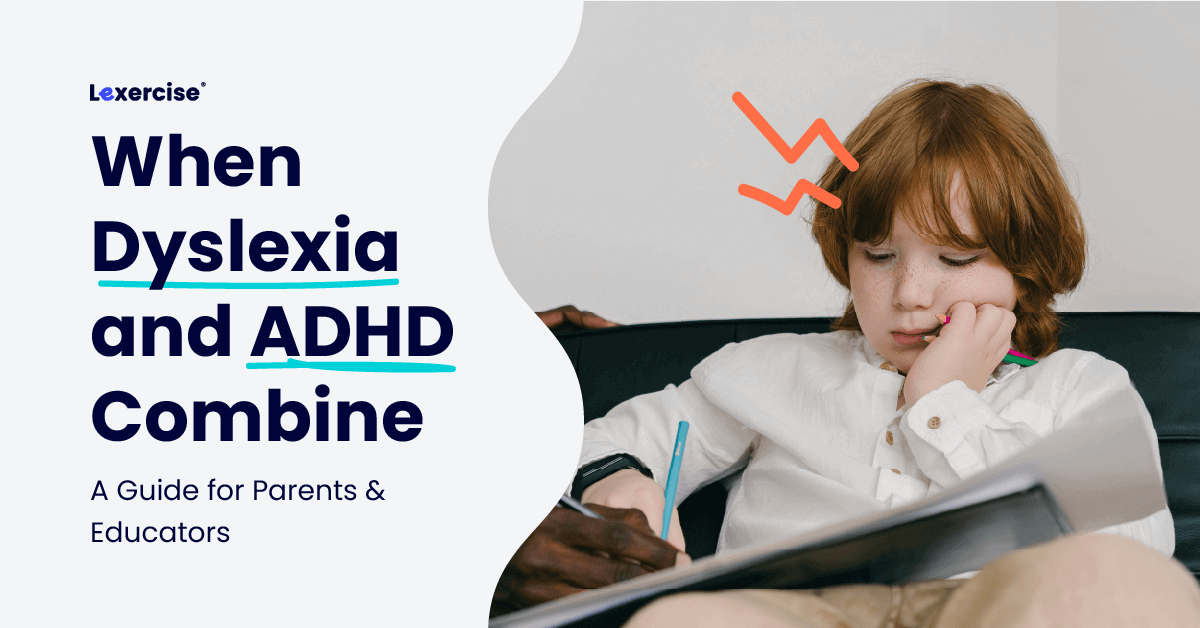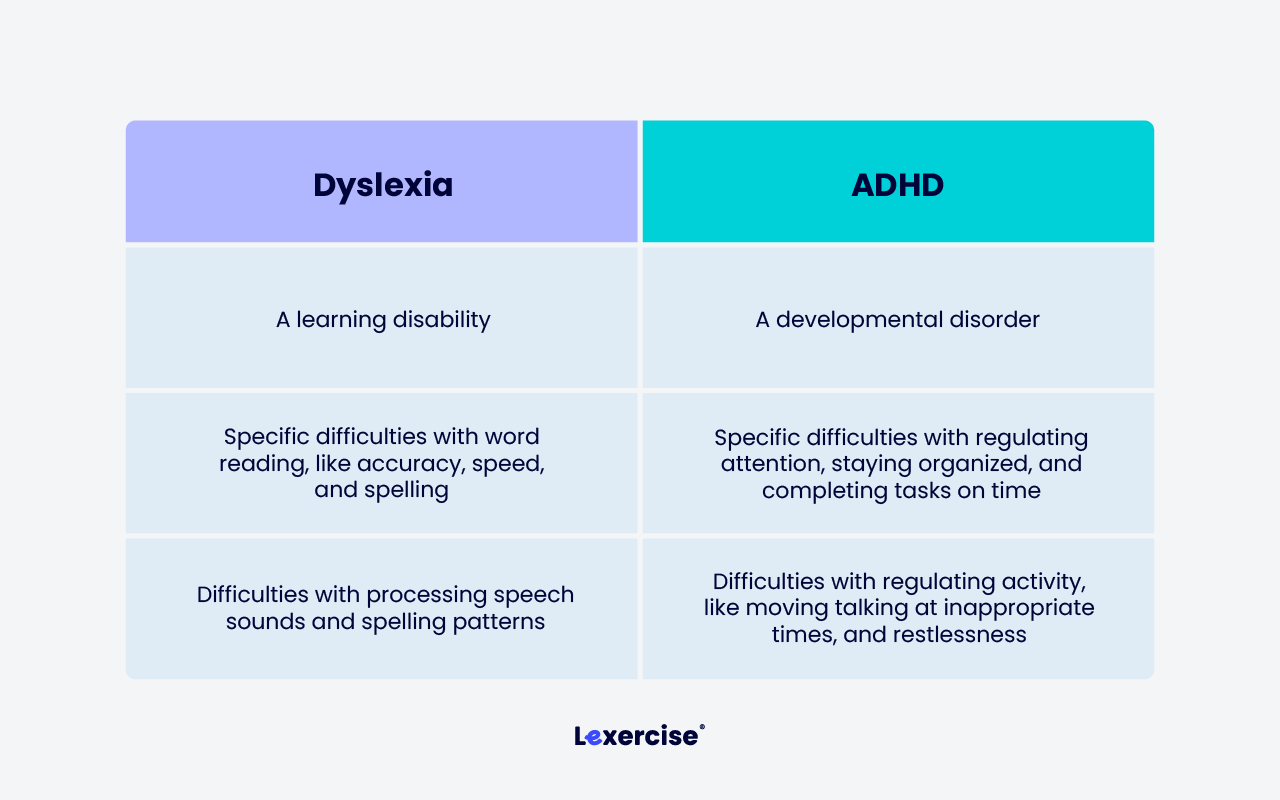When Dyslexia and ADHD Combine: A Guide for Parents & Educators
Written by Sandie Barrie Blackley, Speech-Language Pathologist
Published on October 21, 2025

Watching a student struggle with reading can be confusing. Parents and teachers may notice that the student misreads and/or misspells common words, which could be a sign of dyslexia. On the other hand, they may notice that when the student is reading, they are easily distracted, which could be due to an attention disorder like Attention Deficit Hyperactivity Disorder (ADHD).
And in some cases, it may actually be both conditions.
ADHD and Dyslexia Overlap: Two Diagnoses, One Complicated Picture
Research has confirmed that, while dyslexia and ADHD are different conditions that can be distinctively diagnosed, they often co-occur. Between 30% and 50% of children with ADHD also have a co-occurring reading disorder, and between 20% and 40% of children with dyslexia have ADHD. In other words, a person who has one of these conditions has a higher-than-average chance of having the other, a phenomenon known as Dyslexia-ADHD comorbidity.
Let’s take a step back and examine each of these conditions.
The Difference Between Dyslexia and ADHD
Dyslexia is a learning disability that causes specific difficulties with word reading, including accuracy, speed, or both, and often with spelling, as well. There are often difficulties with processing speech sounds and spelling patterns despite instruction that has been effective for the student’s peers.
ADHD is a developmental disorder that causes difficulties with regulating attention and struggles with staying organized and/or completing tasks on time. There may also be difficulties regulating activity, such as moving around or talking at inappropriate times, and/or feeling restless.

Is Dyslexia Connected to ADHD?
Dyslexia does not cause ADHD, but dyslexia can cause reading and writing-related anxiety, and this anxiety typically disrupts attention. A dyslexic student’s difficulties paying attention when reading or writing might be due to anxiety and/or fatigue rather than ADHD.
Similarly, ADHD does not cause reading or spelling problems, but the associated difficulties with executive functioning can make it challenging to complete reading and writing tasks.
While dyslexia and ADHD are distinct conditions, the brain networks that support reading, spelling, and writing are highly interconnected with those that support executive functioning and attention. This neurological overlap is important because reading and writing can place high demands on the attention and executive function systems.
For example, imagine a developing reader encountering a long, unfamiliar word like amalgamate. Their prefrontal cortex would need to kick in, allowing them to use their working memory to hold the sequence of letter-sounds and syllable chunks in mind while working out the pronunciation of the word.
As readers become more skilled and experienced, another executive function, inhibitory control, allows for more efficient, top-down processing. For example, imagine an experienced, skilled reader encountering the word yacht. Their inhibitory control allows them to suppress the phonetic decoding (“yakt”) and instead recognize the word as a meaningful unit, without getting stuck on the irregular spelling.
ADHD and dyslexia tend to travel as a pair, but they are separate conditions, each needing specific tools and support systems.
In the Classroom: Where Struggles Tend to Show
In the classroom, it can be challenging to identify the root cause of a student’s struggles. Consider Josh, a 4th-grade student. Josh struggles to complete reading and writing assignments, scoring low on high-stakes end-of-year tests; however, he excels with hands-on projects, demonstrating creative thinking and strong oral communication skills. He often takes a leadership role in group projects. Is Josh struggling with written assignments because of dyslexia, ADHD, a combination of the two, or something else? Students like Josh are often mislabeled, provided with a one-size-fits-all approach, or overlooked entirely.
It’s an important distinction, as students with dyslexia and students with ADHD, and those with comorbidities, face very different roadblocks in the classroom.

Students with dyslexia struggle with reading and writing words
While they are typically very able to understand and use spoken words, they have difficulty identifying words from print, and especially with spelling them. Their difficulties often begin with phonemic (speech sound) awareness and phonics (linking speech sounds to spelling patterns).
Students with ADHD struggle with managing their attention and focus.
The difficulties with attention fall into two main categories: 1) inattentive and 2) hyperactive-impulsive. Some children exhibit mostly inattentive behaviors, while others exhibit predominantly hyperactive-impulsive behaviors. Most students with ADHD have a combination of both, and that can create added challenges, especially in group settings like school.
Other conditions may play a role…
And, of course, dyslexia and ADHD are not the only conditions that can cause roadblocks for students. Conditions like autism spectrum disorders and Developmental Language Disorder (DLD) can also present roadblocks. While these are all separate conditions, each with a specific profile, they can co-occur. In addition, all these conditions often cause stress. With ongoing learning struggles, frustration and worry can lead to anxiety, which, by itself, can be a major barrier to learning.
Why Traditional Accommodations May Fall Short
Classroom accommodations are designed to give students with disabilities equal access to the curriculum. Examples of classroom accommodations include preferential seating, extended time, modifying the environment to reduce distractions, and access to text-to-speech technologies (e.g., audiobooks).
Accommodations must be tailored to each student’s individual profile. For example, while a student with dyslexia might benefit from using an audiobook version of a reading assignment, a student with ADHD might find they are more distracted using an audiobook than a paper-based book. Perhaps most importantly, while specifically selected classroom accommodations can help remove barriers to learning, they are not a substitute for interventions designed to teach specific skills and address specific learning gaps.
Dyslexia & ADHD Treatment: Proven Strategies for Success
Over the past three decades, there has been significant progress in defining what works for students with both dyslexia and ADHD.
The treatment approaches that have proven effective for dyslexia include:
- A connectionist approach to literacy instruction, i.e., a structured literacy approach
- High dosage practice to establish reading and writing fluency
- Academic accommodations that help with word identification and spelling, such as audiobooks and spell checkers
The treatment approaches that have proven effective for ADHD include:
- Executive function coaching
- Medication
- Parent training
- Academic accommodations that help manage distractions, such as preferential seating

Some treatments, such as anxiety management and parent training, may be applicable across various conditions, while others, like the use of a structured literacy curriculum, are more narrowly applicable. Combined interventions show promise for treating co-occurring conditions.
For example, a student who struggles with both dyslexia and ADHD would likely benefit from a combination of a structured literacy curriculum with high-dose practice, parent training, and executive function coaching.
Why Getting the Right Diagnosis Early Makes All the Difference
The right diagnosis leads to the right interventions. Across all neurodevelopmental conditions, regardless of the type or severity, early intervention has consistently emerged as the most powerful predictor of positive outcomes.
While it is never too late, brain plasticity is greater in younger children. Early diagnosis is the most effective way to prevent the downward spiral of a “wait to fail” approach that can result in a student being inaccurately labeled as lazy, unmotivated, or unintelligent. The stress and frustration of an undiagnosed condition can lead to the development of even more barriers, such as anxiety, depression, and oppositional behavior.
An accurate diagnosis helps the student, the parent, and teachers understand that the struggles are not due to a lack of effort, but instead result from processing differences that can be overcome. This knowledge can be incredibly validating, replacing self-blame with self-understanding and confidence.
Lexercise: Helping Kids with Dyslexia and ADHD Unlock Their Potential
Lexercise is designed to provide personalized, targeted, evidence-based help for students of all ages who are struggling with literacy, regardless of their location.
- Access Lexercise’s free, online tests to help better understand and describe your child’s difficulties;
- Get a free, online consultation with a qualified Lexercise therapist to discuss your observations and concerns;
- Get a professional assessment, either a Reading and Spelling Inventory or a Language Literacy Evaluation.
Schools can use Lexercise, too! Lexercise for Schools offers professional development and support to teachers, along with the Lexercise Structured Literacy Curriculum’s lessons and practice platform for students.
Improve Your Child’s Reading
Learn more about Lexercise today.
Schedule a FREE
15-minute consultation


